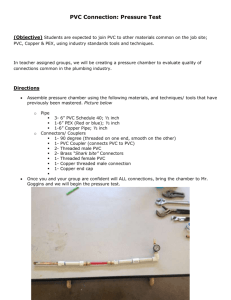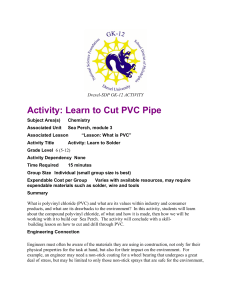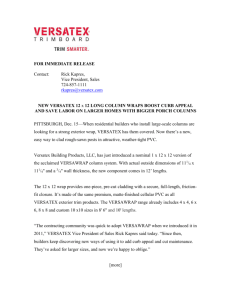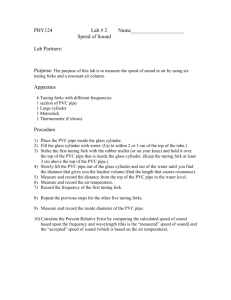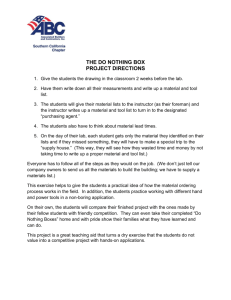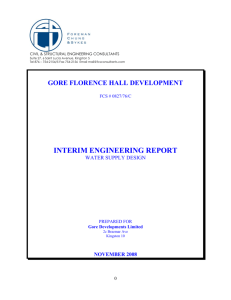Activity: Learn to Cut PVC Pipe
advertisement
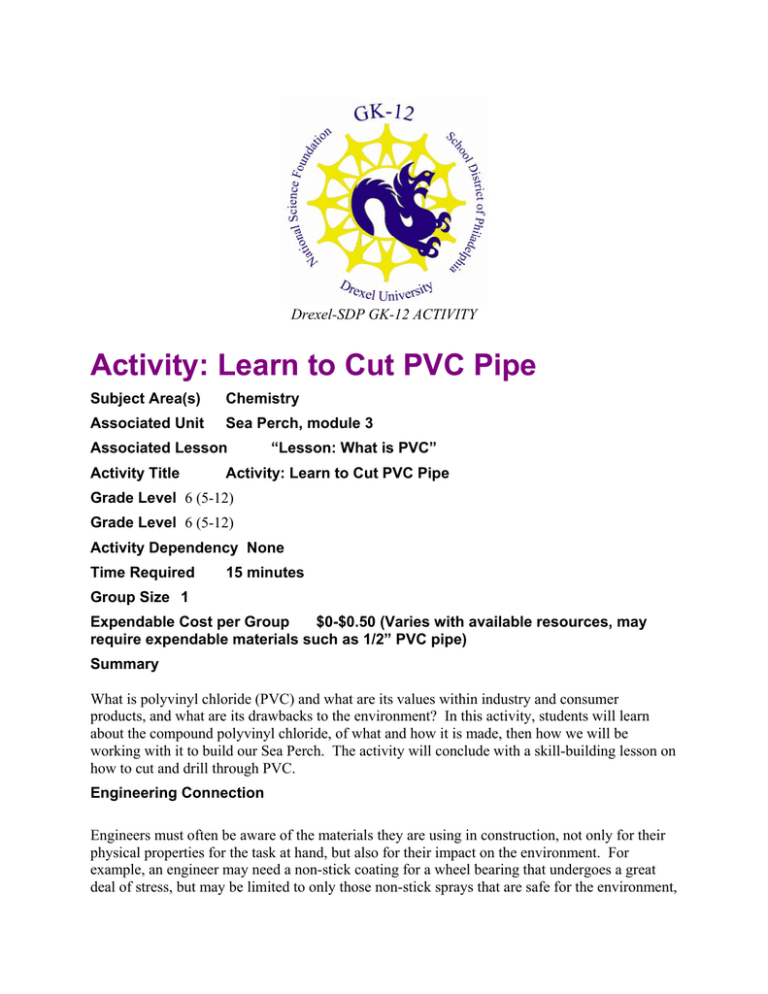
Drexel-SDP GK-12 ACTIVITY Activity: Learn to Cut PVC Pipe Subject Area(s) Chemistry Associated Unit Sea Perch, module 3 Associated Lesson Activity Title “Lesson: What is PVC” Activity: Learn to Cut PVC Pipe Grade Level 6 (5-12) Grade Level 6 (5-12) Activity Dependency None Time Required 15 minutes Group Size 1 Expendable Cost per Group $0-$0.50 (Varies with available resources, may require expendable materials such as 1/2” PVC pipe) Summary What is polyvinyl chloride (PVC) and what are its values within industry and consumer products, and what are its drawbacks to the environment? In this activity, students will learn about the compound polyvinyl chloride, of what and how it is made, then how we will be working with it to build our Sea Perch. The activity will conclude with a skill-building lesson on how to cut and drill through PVC. Engineering Connection Engineers must often be aware of the materials they are using in construction, not only for their physical properties for the task at hand, but also for their impact on the environment. For example, an engineer may need a non-stick coating for a wheel bearing that undergoes a great deal of stress, but may be limited to only those non-stick sprays that are safe for the environment, and safe for the worker who is spraying them. In this exercise, we'll practice cutting some PVC pipe after evaluating some of the pros and cons of PVC materials. Keywords Chemistry, construction, polymers, PVC Educational Standards (PA) • Science: Technology Education - Physical Technologies 3.6.C., Science, Technology and Human Endeavors - Meeting Human Needs 3.8.B, Science, Technology and Human Endeavors - Consequences and Impacts 3.8.C • Math: Computation and Estimation 2.2 Pre-Requisite Knowledge Be familiar with some basic elements in the periodic table Learning Objectives After this lesson, students should be able to: • Measure a length of PVC pipe • Cut PVC Pipe Materials List Each group needs: A 3” or longer piece of ½“ dia. PVC pipe PVC pipe cutters (can time-share among groups) Drill (can time-share among groups) Vice (can time-share among groups) Safety goggles Introduction / Motivation Engineering plans call for the use of plastic piping in just about all of our schools, homes, and streets. What is polyvinyl chloride (PVC) and what are its values within industry and consumer products, and what are its drawbacks to the environment? In this activity, you will learn about the compound polyvinyl chloride, of what and how it is made, then how we will be working with it to build our Sea Perch. This activity is a skill-building lesson on how to cut and drill through PVC. Vocabulary / Definitions 2 Word PVC Polymer Definition Stands for polyvinyl chloride, a polymer. A substance made of a repeated chain of man-made molecules, often referred to as ‘plastic’ Procedure Background The preceding lesson is intended to help students understand the benefits and costs of using PVC-based materials, while this activity is intended as a follow-up to help the students practice the skill of safely cutting PVC pipe to use in their Sea Perch. Before the Activity Review the lesson: What is PVC and re-emphasize safety precautions. With the Students Step 1: Put on safety goggles. Step 2: Drop a piece of PVC into a bucket of water. Does it float? Why or why not? Step 3: Mark a piece of PVC pipe with a marker 1" from the end. Grasp the PVC pipe cutters with your dominant hand and grasp the pipe on the long end with your sub-dominant hand. Squeeze down on the PVC cutters until the pipe is cut in to two. Repeat until you feel comfortable with the process. Step 4: Clamp a piece of PVC into the vice, making sure it will not move if you pull or push one of the overhanging ends of the pipe. Hold the drill with your dominant hand and press down on the flat surface of the vice away from the pipe with your other hand. Hold the drill perpendicular (at a 90 degree angle) from the surface that you will be drilling. Depress the trigger slowly at first, then depress the rest of the way as a hole begins to appear in the pipe. Continue pressing the trigger as you pull the drill out of the pipe. Repeat until you feel comfortable with the process. Step 5: Engage in a discussion with the students. Can they describe some of the properties of the material? Was it hard or soft? Easy to cut through or difficult? Do they think it would flex (bend) if it were a long piece? What other uses (besides pipe) could they think of for the material? Safety Issues • Make sure students wear safety goggles • Be sure the students keep their fingers away from the pipe cutter 3 • • Provide ample space between students Be aware of the location of cords Troubleshooting Tips If the PVC pipe does not cut easily, try TWISTING the pipe as you cut it. Investigating Questions Question 1: What happened to the PVC in water? Why? How could we make it float? Question 2: What is the purpose of drilling holes in the PVC with respect to Sea Perch? Question 3: What other materials could we use for the frame of our Sea Perch? Assessment Pre-Activity Assessment None Activity Embedded Assessment Supervise the students to ensure proper safety procedures. Post-Activity Assessment Did the student properly use the equipment? Were they able to follow the instructions and cleanly cut the piping? Students will be evaluated on a scale from 0 to 4 on: ______________ _____________ _____________ Safety Following Instructions Task Completion Activity Extensions Construct the SeaPerch underwater remote controlled vessel – see http://www.coe.drexel.edu/seaperch/ Owner Drexel University GK-12 Program Contributors Dara Kusic Copyright Copyright 2007 Drexel University GK12 Program. Reproduction permission is granted for nonprofit educational use Version: Mar 2007 4

